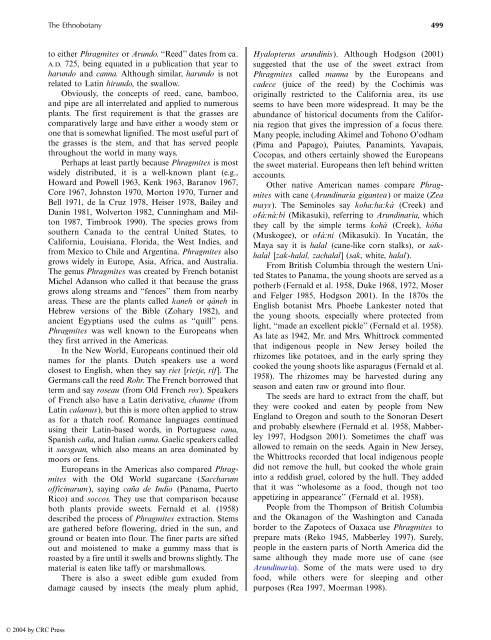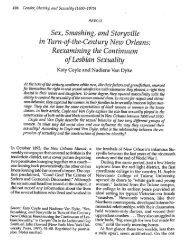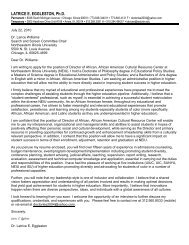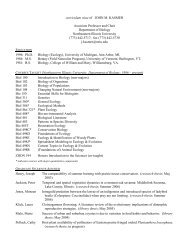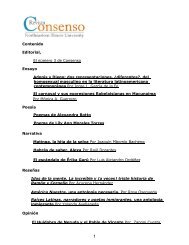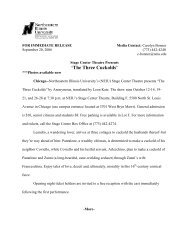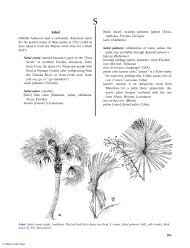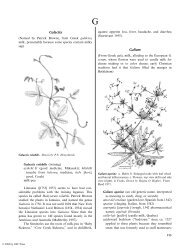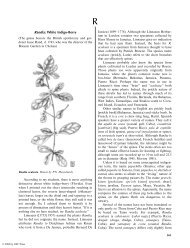Herba Cana - Northeastern Illinois University
Herba Cana - Northeastern Illinois University
Herba Cana - Northeastern Illinois University
Create successful ePaper yourself
Turn your PDF publications into a flip-book with our unique Google optimized e-Paper software.
© 2004 by CRC Press<br />
The Ethnobotany 499<br />
to either Phragmites or Arundo. ‘‘Reed’’ dates from ca.<br />
A.D. 725, being equated in a publication that year to<br />
harundo and canna. Although similar, harundo is not<br />
related to Latin hirundo, the swallow.<br />
Obviously, the concepts of reed, cane, bamboo,<br />
and pipe are all interrelated and applied to numerous<br />
plants. The first requirement is that the grasses are<br />
comparatively large and have either a woody stem or<br />
one that is somewhat lignified. The most useful part of<br />
the grasses is the stem, and that has served people<br />
throughout the world in many ways.<br />
Perhaps at least partly because Phragmites is most<br />
widely distributed, it is a well-known plant (e.g.,<br />
Howard and Powell 1963, Kenk 1963, Baranov 1967,<br />
Core 1967, Johnston 1970, Morton 1970, Turner and<br />
Bell 1971, de la Cruz 1978, Heiser 1978, Bailey and<br />
Danin 1981, Wolverton 1982, Cunningham and Milton<br />
1987, Timbrook 1990). The species grows from<br />
southern <strong>Cana</strong>da to the central United States, to<br />
California, Louisiana, Florida, the West Indies, and<br />
from Mexico to Chile and Argentina. Phragmites also<br />
grows widely in Europe, Asia, Africa, and Australia.<br />
The genus Phragmites was created by French botanist<br />
Michel Adanson who called it that because the grass<br />
grows along streams and ‘‘fences’’ them from nearby<br />
areas. These are the plants called kaneh or qáneh in<br />
Hebrew versions of the Bible (Zohary 1982), and<br />
ancient Egyptians used the culms as ‘‘quill’’ pens.<br />
Phragmites was well known to the Europeans when<br />
they first arrived in the Americas.<br />
In the New World, Europeans continued their old<br />
names for the plants. Dutch speakers use a word<br />
closest to English, when they say riet [rietje, rif]. The<br />
Germans call the reed Rohr. The French borrowed that<br />
term and say roseau (from Old French ros). Speakers<br />
of French also have a Latin derivative, chaume (from<br />
Latin calamus), but this is more often applied to straw<br />
as for a thatch roof. Romance languages continued<br />
using their Latin-based words, in Portuguese cana,<br />
Spanish caña, and Italian canna. Gaelic speakers called<br />
it saesgean, which also means an area dominated by<br />
moors or fens.<br />
Europeans in the Americas also compared Phragmites<br />
with the Old World sugarcane (Saccharum<br />
officinarum), saying caña de Indio (Panama, Puerto<br />
Rico) and soccos. They use that comparison because<br />
both plants provide sweets. Fernald et al. (1958)<br />
described the process of Phragmites extraction. Stems<br />
are gathered before flowering, dried in the sun, and<br />
ground or beaten into flour. The finer parts are sifted<br />
out and moistened to make a gummy mass that is<br />
roasted by a fire until it swells and browns slightly. The<br />
material is eaten like taffy or marshmallows.<br />
There is also a sweet edible gum exuded from<br />
damage caused by insects (the mealy plum aphid,<br />
Hyalopterus arundinis). Although Hodgson (2001)<br />
suggested that the use of the sweet extract from<br />
Phragmites called manna by the Europeans and<br />
cadece (juice of the reed) by the Cochimis was<br />
originally restricted to the California area, its use<br />
seems to have been more widespread. It may be the<br />
abundance of historical documents from the California<br />
region that gives the impression of a focus there.<br />
Many people, including Akimel and Tohono O’odham<br />
(Pima and Papago), Paiutes, Panamints, Yavapais,<br />
Cocopas, and others certainly showed the Europeans<br />
the sweet material. Europeans then left behind written<br />
accounts.<br />
Other native American names compare Phragmites<br />
with cane (Arundinaria gigantea) or maize (Zea<br />
mays). The Seminoles say koha:ha:ká (Creek) and<br />
oɬ á:ná:bí (Mikasuki), referring to Arundinaria, which<br />
they call by the simple terms kohá (Creek), kóha<br />
(Muskogee), or oɬ á:ni (Mikasuki). In Yucatán, the<br />
Maya say it is halal (cane-like corn stalks), or sakhalal<br />
[zak-halal, zachalal] (sak, white, halal).<br />
From British Columbia through the western United<br />
States to Panama, the young shoots are served as a<br />
potherb (Fernald et al. 1958, Duke 1968, 1972, Moser<br />
and Felger 1985, Hodgson 2001). In the 1870s the<br />
English botanist Mrs. Phoebe Lankester noted that<br />
the young shoots, especially where protected from<br />
light, ‘‘made an excellent pickle’’ (Fernald et al. 1958).<br />
As late as 1942, Mr. and Mrs. Whittrock commented<br />
that indigenous people in New Jersey boiled the<br />
rhizomes like potatoes, and in the early spring they<br />
cooked the young shoots like asparagus (Fernald et al.<br />
1958). The rhizomes may be harvested during any<br />
season and eaten raw or ground into flour.<br />
The seeds are hard to extract from the chaff, but<br />
they were cooked and eaten by people from New<br />
England to Oregon and south to the Sonoran Desert<br />
and probably elsewhere (Fernald et al. 1958, Mabberley<br />
1997, Hodgson 2001). Sometimes the chaff was<br />
allowed to remain on the seeds. Again in New Jersey,<br />
the Whittrocks recorded that local indigenous people<br />
did not remove the hull, but cooked the whole grain<br />
into a reddish gruel, colored by the hull. They added<br />
that it was ‘‘wholesome as a food, though not too<br />
appetizing in appearance’’ (Fernald et al. 1958).<br />
People from the Thompson of British Columbia<br />
and the Okanagon of the Washington and <strong>Cana</strong>da<br />
border to the Zapotecs of Oaxaca use Phragmites to<br />
prepare mats (Reko 1945, Mabberley 1997). Surely,<br />
people in the eastern parts of North America did the<br />
same although they made more use of cane (see<br />
Arundinaria). Some of the mats were used to dry<br />
food, while others were for sleeping and other<br />
purposes (Rea 1997, Moerman 1998).


